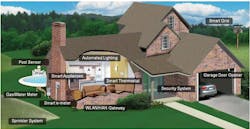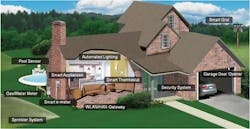A Smart Home Needs Smart Battery Management (.PDF Download)
No doubt about it—the world is getting smarter. Widely available wireless connectivity, low-cost sensors, and low-power embedded microcontrollers have spawned numerous “smart” consumer products, including phones, watches, and credit cards. Behind the scenes, we’re seeing the rise of the smart factory and the smart grid, and researchers are even working on smart dust.
The smart home is part of a wider trend—the Internet of Things (IoT)—that’s bringing big changes to the factory floor, the operating room, and down on the farm. The smart home adds wireless connectivity to a host of formerly “dumb” devices and networks them together to achieve greater energy efficiency, security, and convenience. Figure 1 shows a typical smart-home installation with multiple remote peripheral devices linked to a central gateway (controller) via a wireless LAN or home area network (HAN).
1. The smart home connects many formerly “dumb” devices. Synergies include greater energy efficiency and improved security. (Source: TI blog: “Powering the smart home with a simple charger”)
Powering the Smart Home
Connecting many devices opens up a host of intriguing possibilities, but providing power to such a disparate collection of products poses problems for the system designer, particularly in a home that wasn’t designed to accommodate a “smart” installation.
Some power solutions are relatively obvious. Most smart-home systems rely on a control panel, hub, or base unit in a fixed location that can be located next to an ac outlet. However, the system may also include distributed or mobile wireless sensors, video doorbells, security cameras, or similar peripherals that can’t be conveniently located near a permanent power source, especially in homes built before the IoT revolution.

